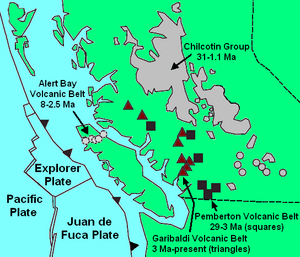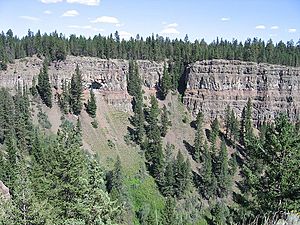Chilcotin Group facts for kids
The Chilcotin Plateau basalts are huge layers of hardened lava found in British Columbia, Canada. Imagine a giant pancake made of rock! These layers were formed by volcanic eruptions that created a flat, high area called a plateau. This plateau runs alongside another volcanic area called the Garibaldi Volcanic Belt, about 150 kilometers (93 miles) from the Pacific Ocean.
These ancient lava flows cover a very large part of the Pacific Northwest, possibly as much as 50,000 square kilometers (about 19,000 square miles). That's bigger than many countries! This massive amount of lava is known as a medium-sized large igneous province, which means it's a huge area covered by volcanic rock. The total volume of this lava is estimated to be around 3,300 cubic kilometers.
Contents
What Are the Chilcotin Plateau Basalts?
The Chilcotin Plateau basalts are made of a type of volcanic rock called basalt. Basalt is a dark, fine-grained rock that forms when lava cools quickly. When volcanoes erupt, they sometimes release huge amounts of very runny lava. This lava can flow for long distances, covering vast areas and forming flat layers. Over millions of years, these layers build up to create a plateau.
These particular basalts formed in British Columbia's Interior Plateau. This region experienced a lot of volcanic activity a long, long time ago. The eruptions were not like explosive volcanoes we often think of. Instead, they were more like cracks in the Earth's surface, allowing lava to pour out steadily.
When Did These Volcanoes Erupt?
The main eruptions that created the Chilcotin Plateau basalts happened during two major periods. The first was between 6 and 10 million years ago. This time is known as the Miocene epoch. The second major period was between 2 and 3 million years ago, during the Pliocene epoch. Most of the basalt we see today was formed during these two very active times.
Even after these big eruptions, smaller ones continued for a long time. These smaller events happened from about 1.6 million years ago until as recently as 10,000 years ago. This means that for millions of years, lava was slowly building up the landscape of the Chilcotin Plateau.
Why Are They Important?
The Chilcotin Plateau basalts are important for several reasons:
- Geological History: They tell us a lot about the Earth's past and how the landscape of British Columbia was formed.
- Unique Landscapes: The hardened lava has created unique landforms, including cliffs and canyons, which are now home to various plants and animals.
- Water Flow: The layers of basalt can affect how water flows underground, influencing rivers and groundwater.
Studying these ancient lava flows helps scientists understand how large volcanic areas form and how they can shape our planet over millions of years.
Images for kids
-
Chilko River and cliffs made of lava flows and ash beds





